Functional Analysis of Stress Resistance of Bacillus cereus SCL10 Strain Based on Whole-Genome Sequencing
Abstract
:1. Introduction
2. Materials and Methods
2.1. Isolation and Culture of the Strain
2.2. Genomic DNA Extraction and Whole-Genome Sequencing
2.3. Genome Component Prediction
2.4. Genome Function Annotation
2.5. Comparative Genomic Analysis
3. Results
3.1. Identification of B. cereus by WGS
3.2. Composition of the Overall B. cereus SCL10 Strain Genome
3.3. General Functions of B. cereus SCL10 Strain Annotation
3.4. Genes Related to Flagellum and Enzymes in Genomic Island Analysis
3.5. B. cereus SCL10 Strain Multiple Pathogenic Factors and Antibiotic Resistance
3.6. Comparative Genomics of B. cereus SCL10 Strain
3.7. Stress-Resistance Genes Related to Spores and Biofilms
3.8. Stress-Resistance Genes Related to Other Biological Processes
4. Discussion
5. Conclusions
Supplementary Materials
Author Contributions
Funding
Institutional Review Board Statement
Informed Consent Statement
Data Availability Statement
Acknowledgments
Conflicts of Interest
References
- Zeng, Q.; Xie, J.; Li, Y.; Gao, T.; Xu, C.; Wang, Q. Comparative genomic and functional analyses of four sequenced Bacillus cereus genomes reveal conservation of genes relevant to plant-growth-promoting traits. Sci. Rep. 2018, 8, 17009. [Google Scholar] [CrossRef] [PubMed]
- Dietrich, R.; Jessberger, N.; Ehling-Schulz, M.; Märtlbauer, E.; Granum, P.E. The Food Poisoning Toxins of Bacillus cereus. Toxins 2021, 13, 98. [Google Scholar] [CrossRef] [PubMed]
- Enosi Tuipulotu, D.; Mathur, A.; Ngo, C.; Man, S.M. Bacillus cereus: Epidemiology, Virulence Factors, and Host-Pathogen Interactions. Trends Microbiol. 2021, 29, 458–471. [Google Scholar] [CrossRef] [PubMed]
- Butcher, M.; Puiu, D.; Romagnoli, M.; Carroll, K.C.; Salzberg, S.L.; Nauen, D.W. Rapidly fatal infection with Bacillus cereus/thuringiensis: Genome assembly of the responsible pathogen and consideration of possibly contributing toxins. Diagn. Microbiol. Infect. Dis. 2021, 101, 115534. [Google Scholar] [CrossRef] [PubMed]
- Lv, R.; Zou, M.; Chantapakul, T.; Chen, W.; Muhammad, A.I.; Zhou, J.; Ding, T.; Ye, X.; Liu, D. Effect of ultrasonication and thermal and pressure treatments, individually and combined, on inactivation of Bacillus cereus spores. Appl. Microbiol. Biotechnol. 2019, 103, 2329–2338. [Google Scholar] [CrossRef]
- Jovanovic, J.; Ornelis, V.F.M.; Madder, A.; Rajkovic, A. Bacillus cereus food intoxication and toxicoinfection. Compr. Rev. Food Sci. Food Saf. 2021, 20, 3719–3761. [Google Scholar] [CrossRef] [PubMed]
- Seixas, A.F.; Quendera, A.P.; Sousa, J.P.; Silva, A.F.Q.; Arraiano, C.M.; Andrade, J.M. Bacterial Response to Oxidative Stress and RNA Oxidation. Front. Genet. 2021, 12, 821535. [Google Scholar] [CrossRef] [PubMed]
- Ezraty, B.; Gennaris, A.; Barras, F.; Collet, J.F. Oxidative stress, protein damage and repair in bacteria. Nat. Rev. Microbiol. 2017, 15, 385–396. [Google Scholar] [CrossRef] [PubMed]
- Majed, R.; Faille, C.; Kallassy, M.; Gohar, M. Bacillus cereus Biofilms-Same, Only Different. Front. Microbiol. 2016, 7, 1054. [Google Scholar] [CrossRef]
- Checinska, A.; Paszczynski, A.; Burbank, M. Bacillus and Other Spore-Forming Genera: Variations in Responses and Mechanisms for Survival. Annu. Rev. Food Sci. Technol. 2015, 6, 351–369. [Google Scholar] [CrossRef]
- Setlow, P. Spore Resistance Properties. Microbiol. Spectr. 2014, 2, 319–332. [Google Scholar] [CrossRef] [PubMed]
- Delbrück, A.I.; Zhang, Y.; Heydenreich, R.; Mathys, A. Bacillus spore germination at moderate high pressure: A review on underlying mechanisms, influencing factors, and its comparison with nutrient germination. Compr. Rev. Food Sci. Food Saf. 2021, 20, 4159–4181. [Google Scholar] [CrossRef] [PubMed]
- Vestby, L.K.; Grønseth, T.; Simm, R.; Nesse, L.L. Bacterial Biofilm and its Role in the Pathogenesis of Disease. Antibiotics 2020, 9, 59. [Google Scholar] [CrossRef] [PubMed]
- Sadiq, F.A.; Flint, S.; Li, Y.; Ou, K.; Yuan, L.; He, G.Q. Phenotypic and genetic heterogeneity within biofilms with particular emphasis on persistence and antimicrobial tolerance. Future Microbiol. 2017, 12, 1087–1107. [Google Scholar] [CrossRef]
- Chang, T.; Rosch, J.W.; Gu, Z.; Hakim, H.; Hewitt, C.; Gaur, A.; Wu, G.; Hayden, R.T. Whole-Genome Characterization of Bacillus cereus Associated with Specific Disease Manifestations. Infect. Immun. 2018, 86, e00574-17. [Google Scholar] [CrossRef] [PubMed]
- Carroll, L.M.; Wiedmann, M.; Kovac, J. Proposal of a Taxonomic Nomenclature for the Bacillus cereus Group Which Reconciles Genomic Definitions of Bacterial Species with Clinical and Industrial Phenotypes. mBio 2020, 11, e00034-20. [Google Scholar] [CrossRef]
- Mazutis, L.; Gilbert, J.; Ung, W.L.; Weitz, D.A.; Griffiths, A.D.; Heyman, J.A. Single-cell analysis and sorting using droplet-based microfluidics. Nat. Protoc. 2013, 8, 870–891. [Google Scholar] [CrossRef] [PubMed]
- Lim, H.J.; Lee, E.H.; Yoon, Y.; Chua, B.; Son, A. Portable lysis apparatus for rapid single-step DNA extraction of Bacillus subtilis. J. Appl. Microbiol. 2016, 120, 379–387. [Google Scholar] [CrossRef] [PubMed]
- Benson, G. Tandem repeats finder: A program to analyze DNA sequences. Nucleic Acids Res. 1999, 27, 573–580. [Google Scholar] [CrossRef]
- Gardner, P.P.; Daub, J.; Tate, J.G.; Nawrocki, E.P.; Kolbe, D.L.; Lindgreen, S.; Wilkinson, A.C.; Finn, R.D.; Griffiths-Jones, S.; Eddy, S.R.; et al. Rfam: Updates to the RNA families database. Nucleic Acids Res. 2009, 37, D136–D140. [Google Scholar] [CrossRef]
- Li, W.; Jaroszewski, L.; Godzik, A. Tolerating some redundancy significantly speeds up clustering of large protein databases. Bioinformatics 2002, 18, 77–82. [Google Scholar] [CrossRef]
- Medema, M.H.; Blin, K.; Cimermancic, P.; de Jager, V.; Zakrzewski, P.; Fischbach, M.A.; Weber, T.; Takano, E.; Breitling, R. antiSMASH: Rapid identification, annotation and analysis of secondary metabolite biosynthesis gene clusters in bacterial and fungal genome sequences. Nucleic Acids Res. 2011, 39, W339–W346. [Google Scholar] [CrossRef] [PubMed]
- Jia, B.; Raphenya, A.R.; Alcock, B.; Waglechner, N.; Guo, P.; Tsang, K.K.; Lago, B.A.; Dave, B.M.; Pereira, S.; Sharma, A.N.; et al. CARD 2017: Expansion and model-centric curation of the comprehensive antibiotic resistance database. Nucleic Acids Res 2017, 45, D566–D573. [Google Scholar] [CrossRef] [PubMed]
- Soni, A.; Oey, I.; Silcock, P.; Bremer, P. Bacillus Spores in the Food Industry: A Review on Resistance and Response to Novel Inactivation Technologies. Compr. Rev. Food Sci. Food Saf. 2016, 15, 1139–1148. [Google Scholar] [CrossRef] [PubMed]
- Brown, E.; Dessai, U.; McGarry, S.; Gerner-Smidt, P. Use of Whole-Genome Sequencing for Food Safety and Public Health in the United States. Foodborne Pathog. Dis. 2019, 16, 441–450. [Google Scholar] [CrossRef] [PubMed]
- Sen, A.; Imlay, J.A. How Microbes Defend Themselves From Incoming Hydrogen Peroxide. Front. Immunol. 2021, 12, 667343. [Google Scholar] [CrossRef] [PubMed]
- Jacobson, F.S.; Morgan, R.W.; Christman, M.F.; Ames, B.N. An alkyl hydroperoxide reductase from Salmonella typhimurium involved in the defense of DNA against oxidative damage. Purification and properties. J. Biol. Chem. 1989, 264, 1488–1496. [Google Scholar] [CrossRef] [PubMed]
- Meireles, D.A.; da Silva Neto, J.F.; Domingos, R.M.; Alegria, T.G.P.; Santos, L.C.M.; Netto, L.E.S. Ohr-OhrR, a neglected and highly efficient antioxidant system: Structure, catalysis, phylogeny, regulation, and physiological roles. Free Radic. Biol. Med. 2022, 185, 6–24. [Google Scholar] [CrossRef] [PubMed]
- Shu, J.C.; Soo, P.C.; Chen, J.C.; Hsu, S.H.; Chen, L.C.; Chen, C.Y.; Liang, S.H.; Buu, L.M.; Chen, C.C. Differential regulation and activity against oxidative stress of Dps proteins in Bacillus cereus. Int. J. Med. Microbiol. 2013, 303, 662–673. [Google Scholar] [CrossRef]
- Shtykova, E.V.; Petoukhov, M.V.; Mozhaev, A.A. Formation of Iron Oxide Nanoparticles in the Internal Cavity of Ferritin-Like Dps Protein: Studies by Anomalous X-ray Scattering. Biochemistry 2022, 87, 511–523. [Google Scholar] [CrossRef]
- Hecker, M.; Völker, U. General stress response of Bacillus subtilis and other bacteria. Adv. Microb. Physiol. 2001, 44, 35–91. [Google Scholar] [CrossRef] [PubMed]
- Illigmann, A.; Thoma, Y.; Pan, S.; Reinhardt, L.; Brötz-Oesterhelt, H. Contribution of the Clp Protease to Bacterial Survival and Mitochondrial Homoeostasis. Microb. Physiol. 2021, 31, 260–279. [Google Scholar] [CrossRef] [PubMed]
- Alam, A.; Bröms, J.E.; Kumar, R.; Sjöstedt, A. The Role of ClpB in Bacterial Stress Responses and Virulence. Front. Mol. Biosci. 2021, 8, 668910. [Google Scholar] [CrossRef] [PubMed]
- Nicholson, W.L.; Munakata, N.; Horneck, G.; Melosh, H.J.; Setlow, P. Resistance of Bacillus endospores to extreme terrestrial and extraterrestrial environments. Microbiol. Mol. Biol. Rev. 2000, 64, 548–572. [Google Scholar] [CrossRef] [PubMed]
- Pawluk, A.M.; Kim, D.; Jin, Y.H.; Jeong, K.C.; Mah, J.H. Biofilm-associated heat resistance of Bacillus cereus spores in vitro and in a food model, Cheonggukjang jjigae. Int. J. Food Microbiol. 2022, 363, 109505. [Google Scholar] [CrossRef] [PubMed]
- Nicholson, W.L.; Fajardo-Cavazos, P.; Rebeil, R.; Slieman, T.A.; Riesenman, P.J.; Law, J.F.; Xue, Y. Bacterial endospores and their significance in stress resistance. Antonie Van. Leeuwenhoek 2002, 81, 27–32. [Google Scholar] [CrossRef] [PubMed]
- Huang, Q.; Zhang, Z.; Liu, Q.; Liu, F.; Liu, Y.; Zhang, J.; Wang, G. SpoVG is an important regulator of sporulation and affects biofilm formation by regulating Spo0A transcription in Bacillus cereus 0-9. BMC Microbiol. 2021, 21, 172. [Google Scholar] [CrossRef] [PubMed]
- Xing, Y.; Harper, W.F., Jr. Bacillus spore awakening: Recent discoveries and technological developments. Curr. Opin. Biotechnol. 2020, 64, 110–115. [Google Scholar] [CrossRef] [PubMed]
- Faßhauer, P.; Busche, T.; Kalinowski, J.; Mäder, U.; Poehlein, A.; Daniel, R.; Stülke, J. Functional Redundancy and Specialization of the Conserved Cold Shock Proteins in Bacillus subtilis. Microorganisms 2021, 9, 1434. [Google Scholar] [CrossRef]
- Zhao, X.; Wang, Y.; Shang, Q.; Li, Y.; Hao, H.; Zhang, Y.; Guo, Z.; Yang, G.; Xie, Z.; Wang, R. Collagen-like proteins (ClpA, ClpB, ClpC, and ClpD) are required for biofilm formation and adhesion to plant roots by Bacillus amyloliquefaciens FZB42. PLoS ONE 2015, 10, e0117414. [Google Scholar] [CrossRef]
- Taylor, W.; Camilleri, E.; Craft, D.L.; Korza, G.; Granados, M.R.; Peterson, J.; Szczpaniak, R.; Weller, S.K.; Moeller, R.; Douki, T.; et al. DNA Damage Kills Bacterial Spores and Cells Exposed to 222-Nanometer UV Radiation. Appl. Environ. Microbiol. 2020, 86, e03039-19. [Google Scholar] [CrossRef] [PubMed]
- Xue, Y.; Nicholson, W.L. The two major spore DNA repair pathways, nucleotide excision repair and spore photoproduct lyase, are sufficient for the resistance of Bacillus subtilis spores to artificial UV-C and UV-B but not to solar radiation. Appl. Environ. Microbiol. 1996, 62, 2221–2227. [Google Scholar] [CrossRef] [PubMed]
- Bonde, N.J.; Romero, Z.J.; Chitteni-Pattu, S.; Cox, M.M. RadD is a RecA-dependent accessory protein that accelerates DNA strand exchange. Nucleic Acids Res. 2022, 50, 2201–2210. [Google Scholar] [CrossRef] [PubMed]
- Nirwal, S.; Czarnocki-Cieciura, M.; Chaudhary, A.; Zajko, W.; Skowronek, K.; Chamera, S.; Figiel, M.; Nowotny, M. Mechanism of RecF-RecO-RecR cooperation in bacterial homologous recombination. Nat. Struct. Mol. Biol. 2023, 30, 650–660. [Google Scholar] [CrossRef] [PubMed]
- Setlow, P. Spores of Bacillus subtilis: Their resistance to and killing by radiation, heat and chemicals. J. Appl. Microbiol. 2006, 101, 514–525. [Google Scholar] [CrossRef]
- Yang, L.; Jian, Y.; Setlow, P.; Li, L. Spore photoproduct within DNA is a surprisingly poor substrate for its designated repair enzyme—The spore photoproduct lyase. DNA Repair. 2017, 53, 31–42. [Google Scholar] [CrossRef]
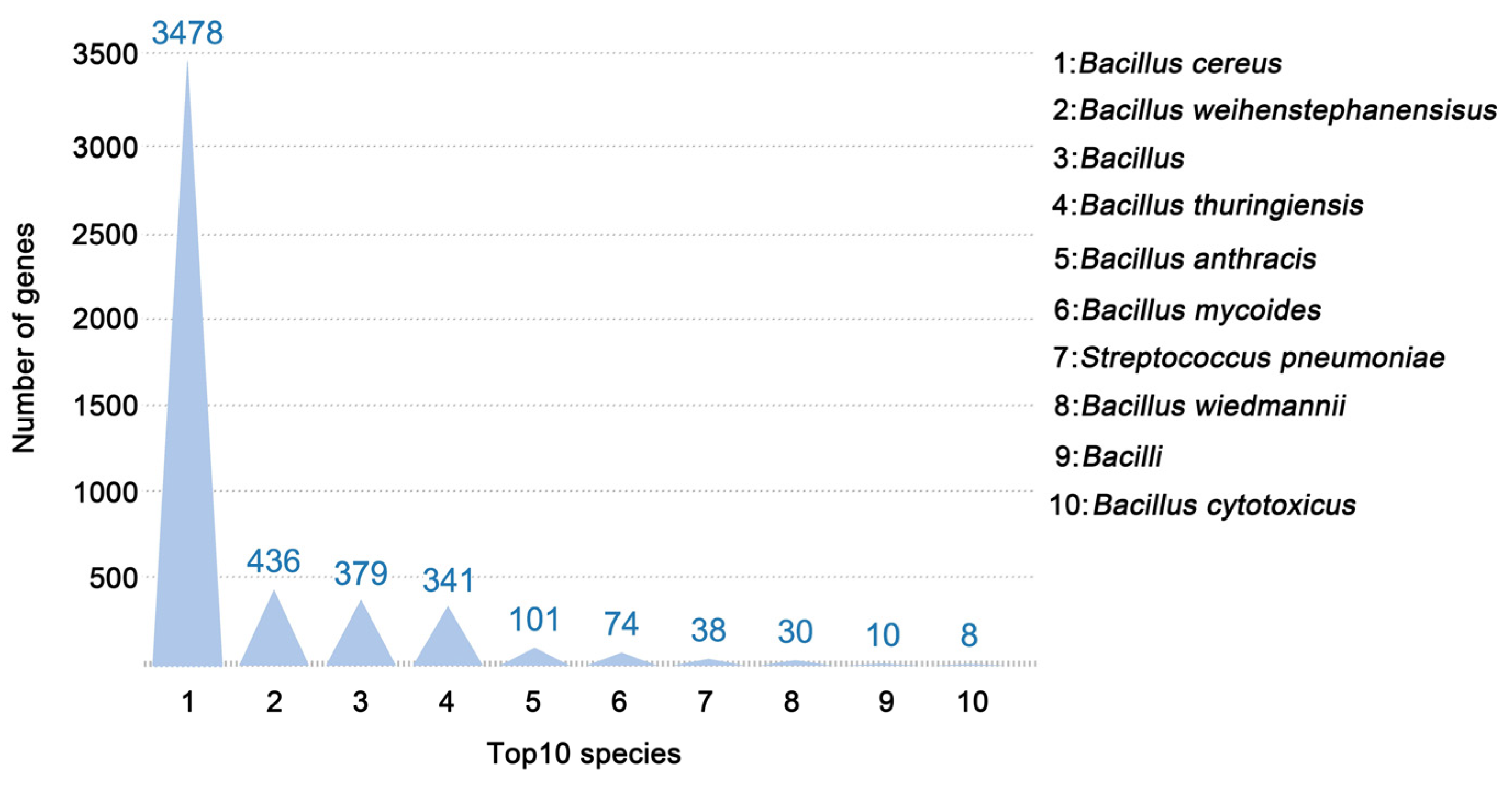
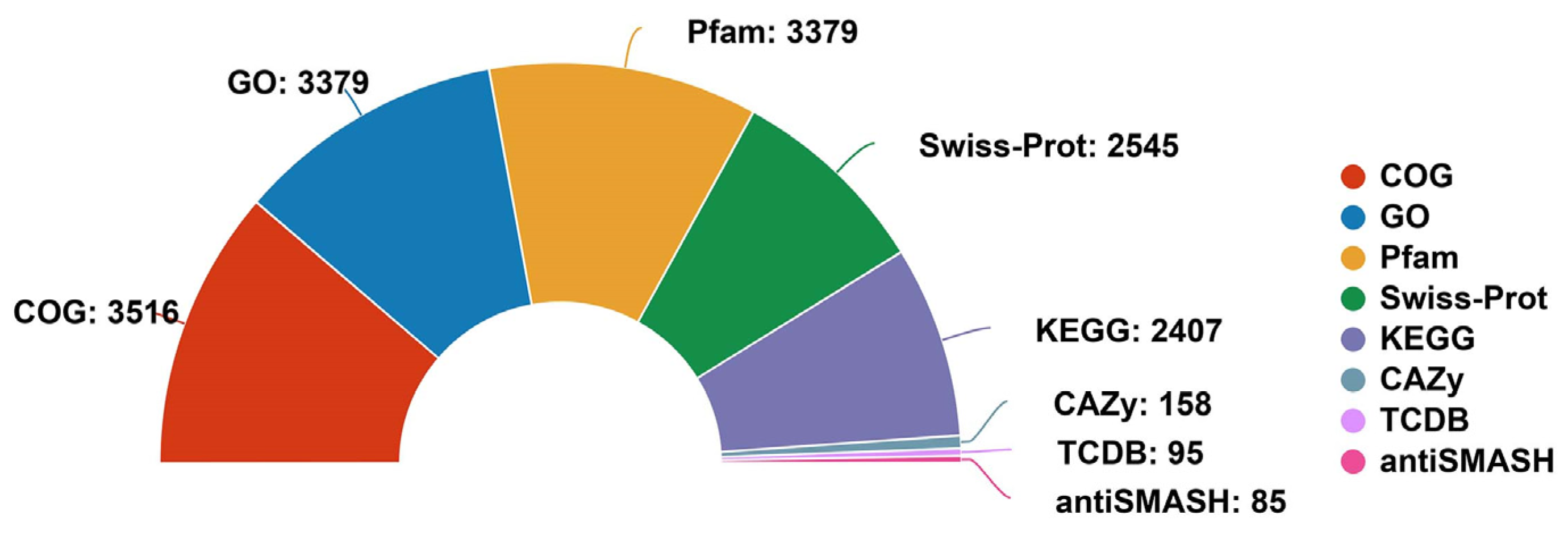
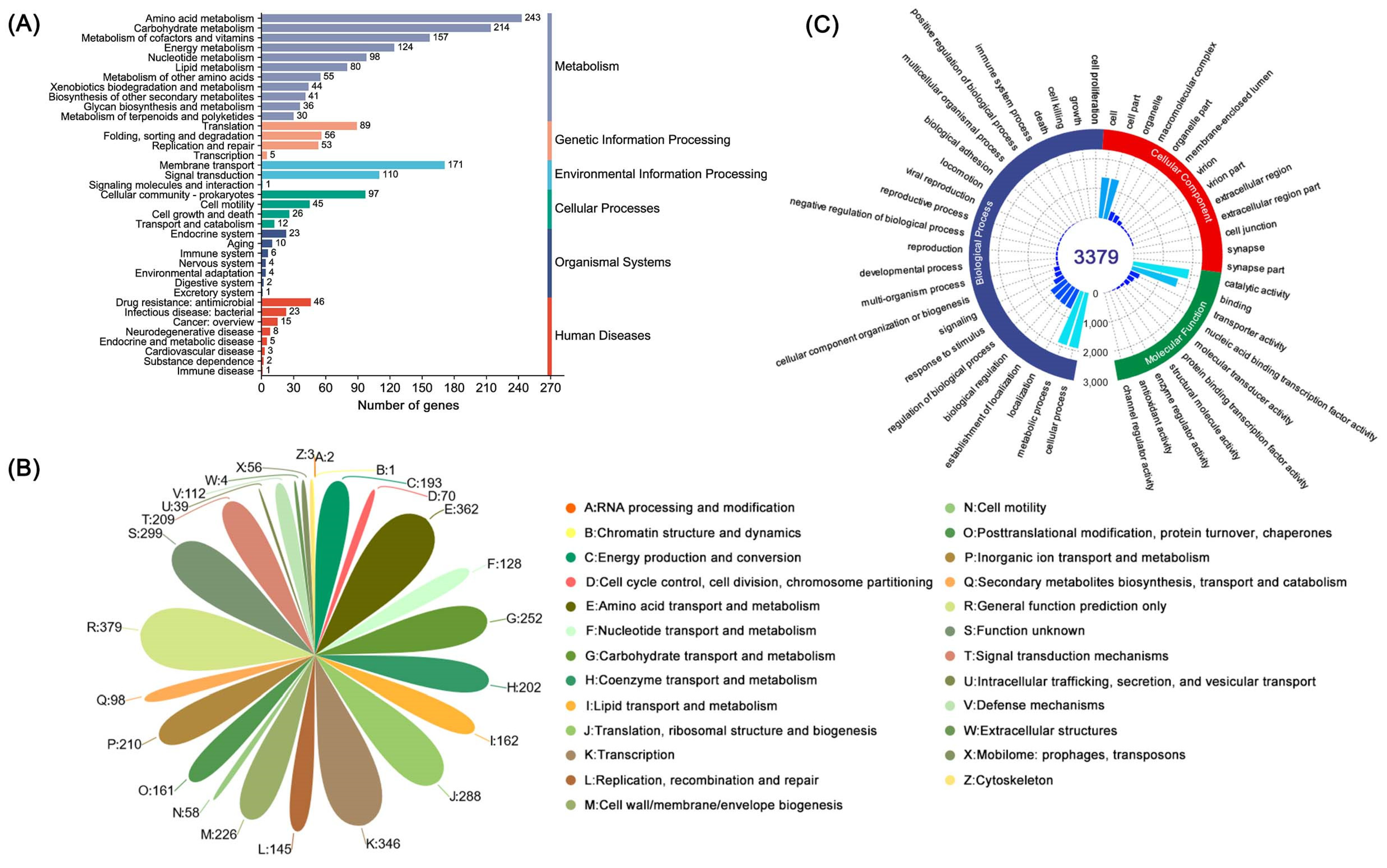
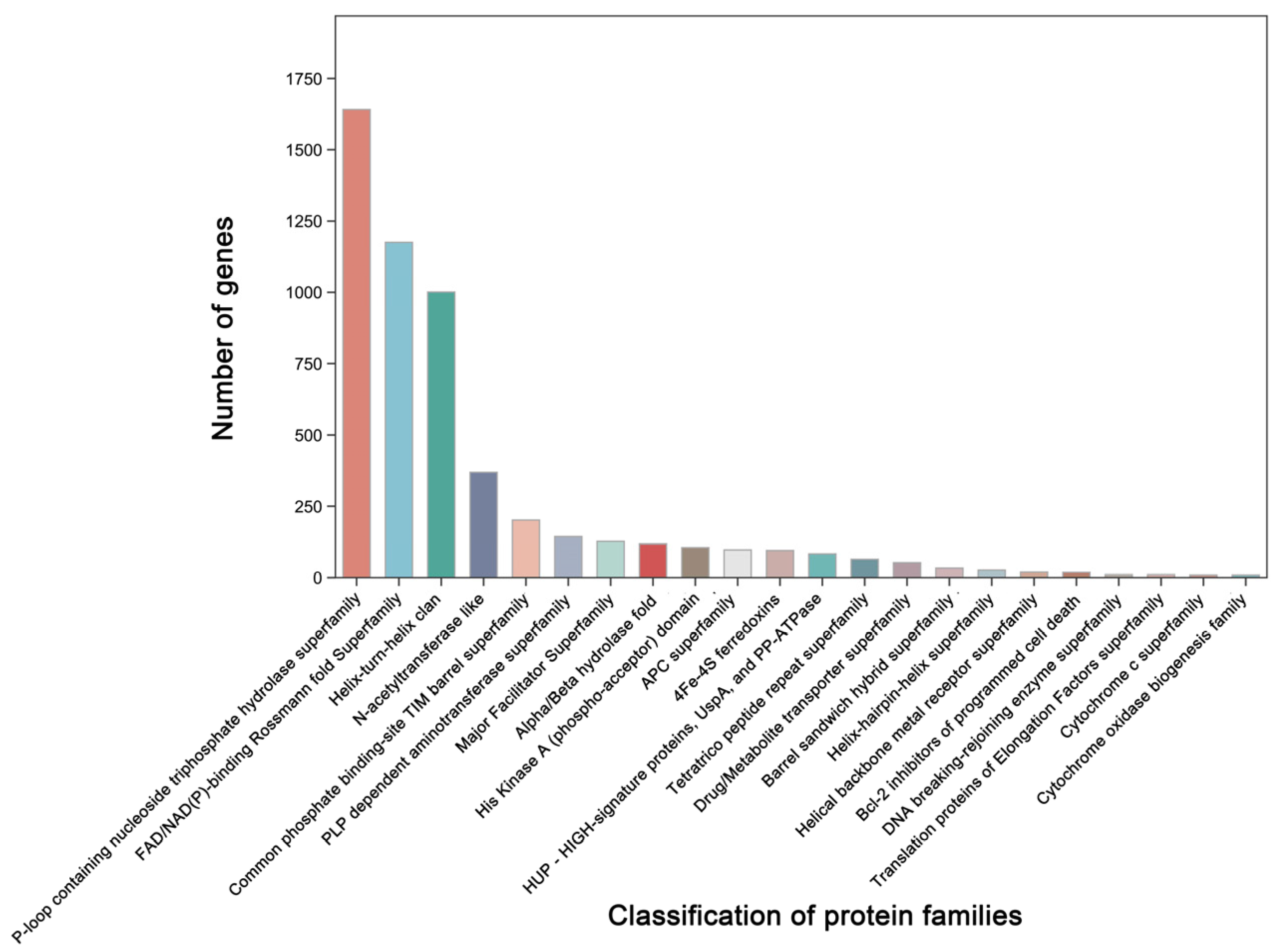
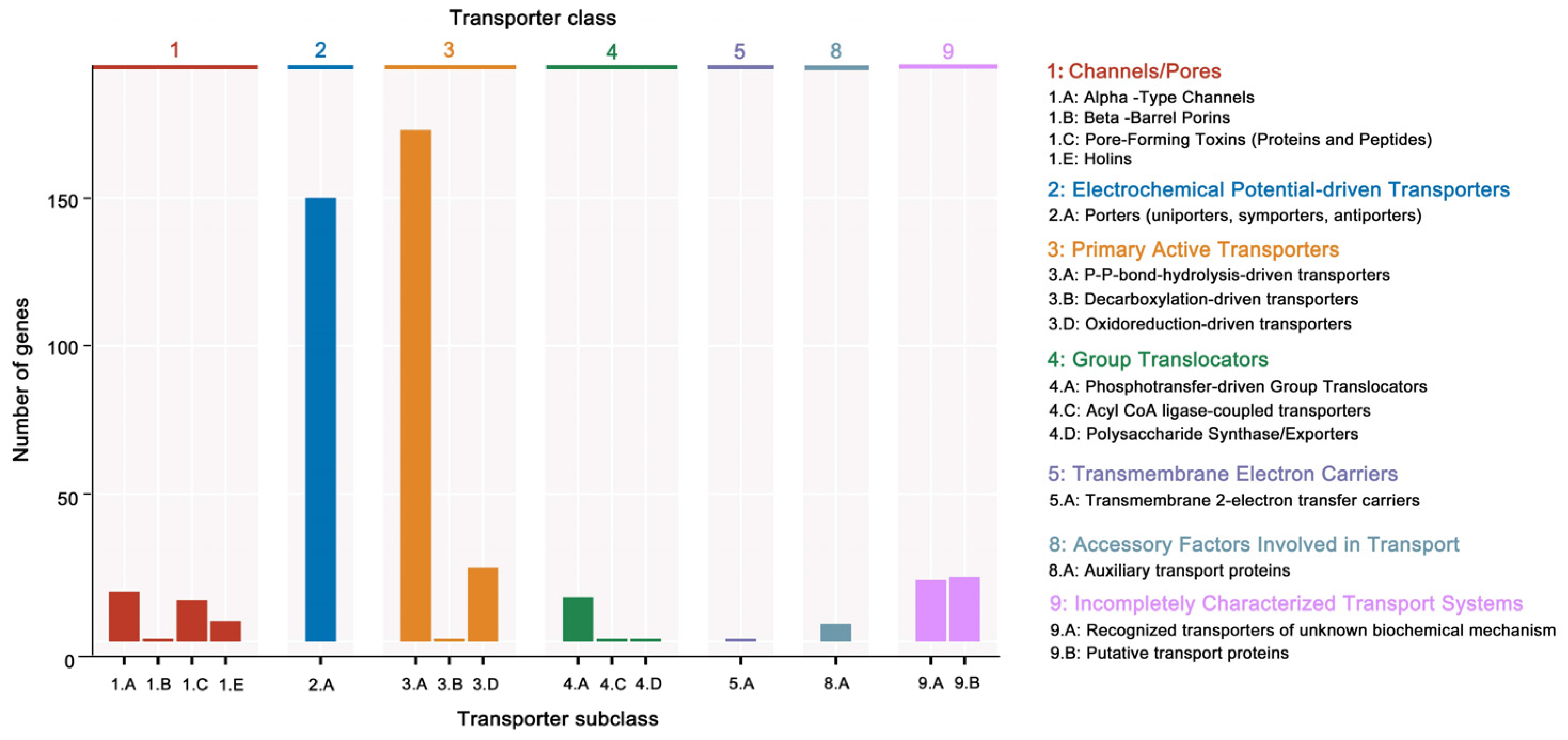
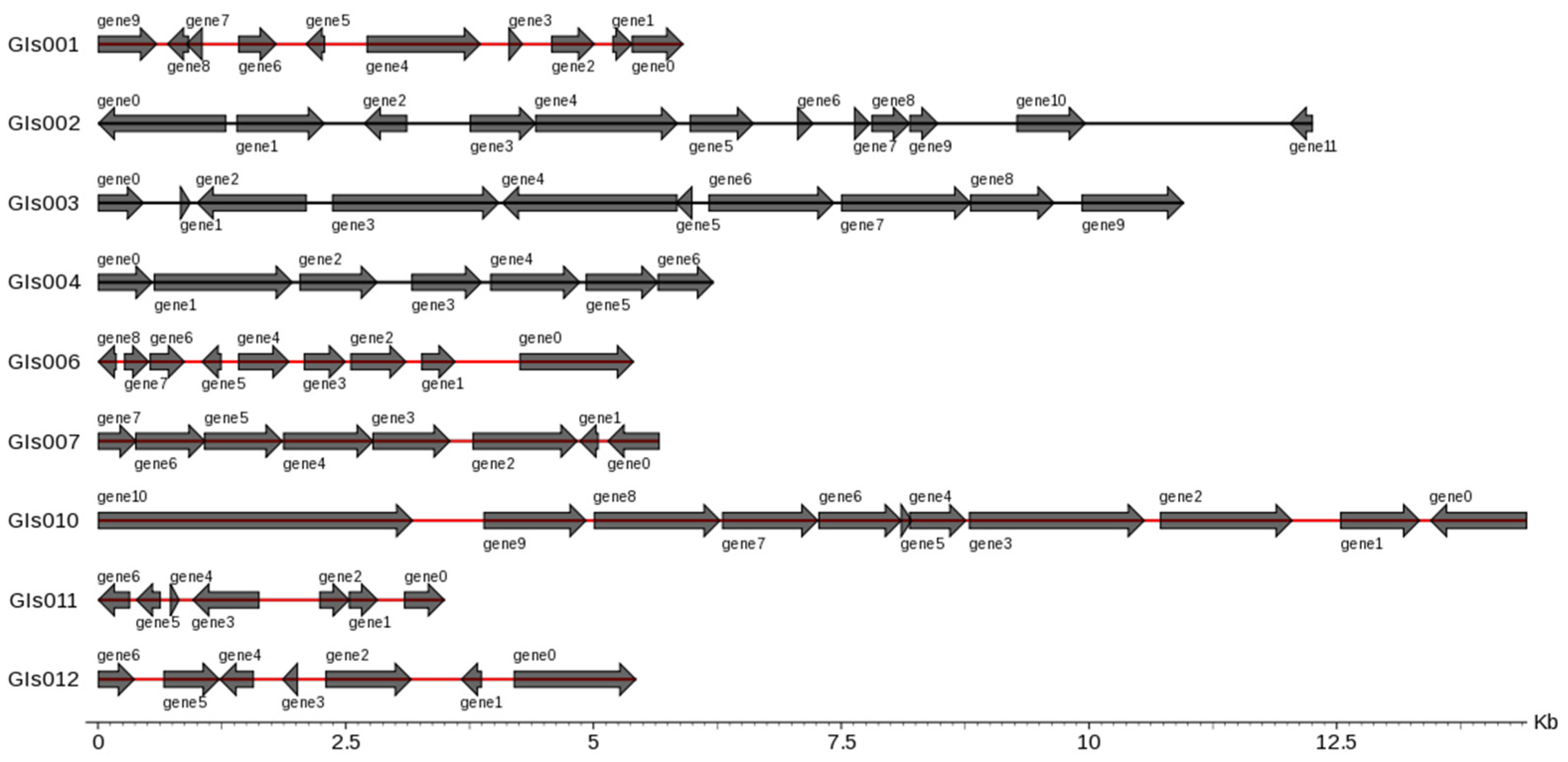

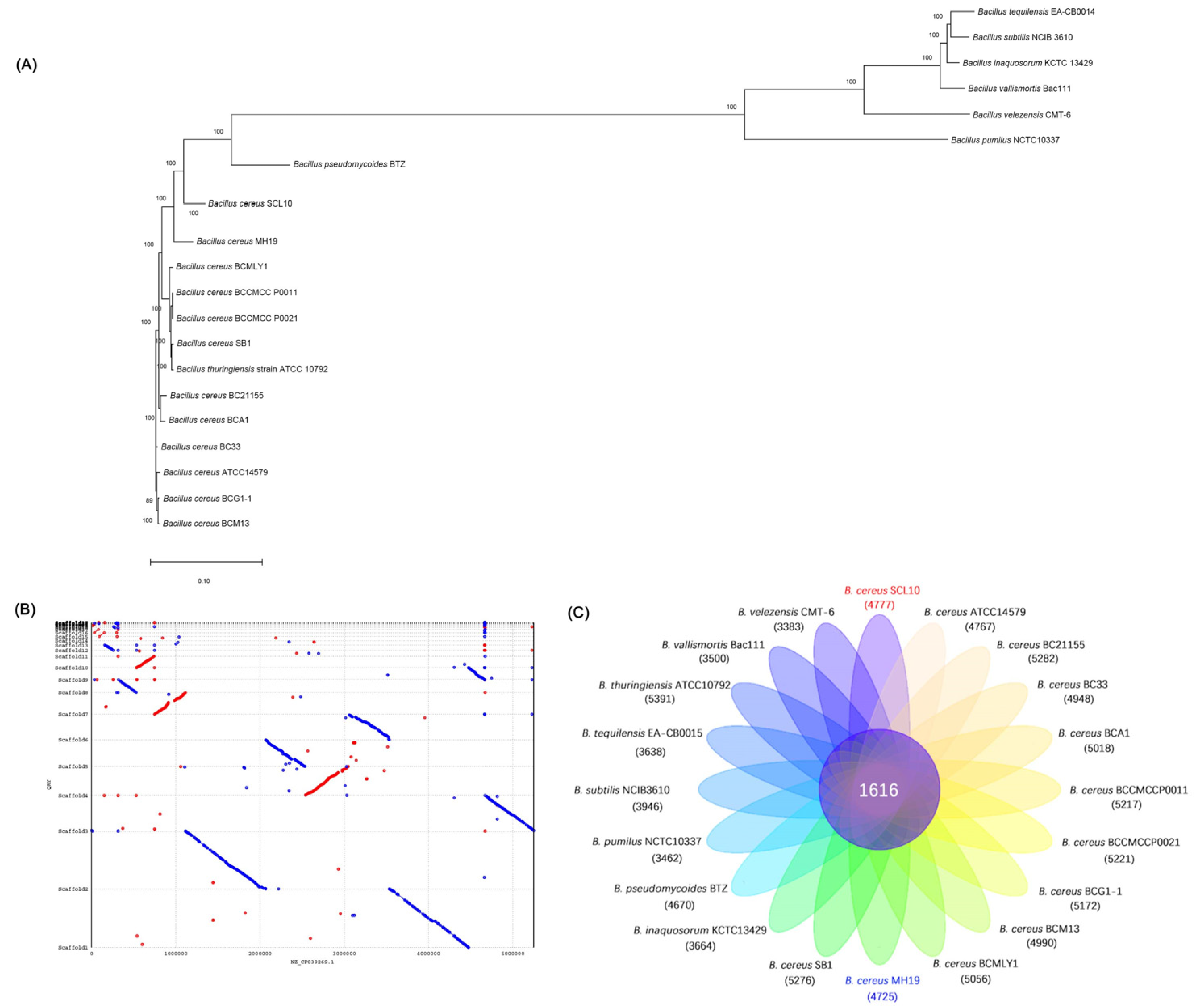
| Type | Length (bp) | Amount |
|---|---|---|
| Contig count | 4,979,162 | 34 |
| Genome size | 4,979,162 | |
| Gene average | 807 | |
| Contig N50 | 408,461 | |
| GC content (%) | 35.42 | |
| Total length of coding sequence | 4,167,474 | 5167 |
| Protein-encoding genes with functional assignment | 4955 | |
| Long terminal repeat | 8525 | 115 |
| Total transposon length | 2061 | 33 |
| Long scattered sequence | 1853 | 25 |
| Short scattered sequence | 787 | 10 |
| Rolling circle | 0 | 0 |
| Genomic island | 137,391 | 12 |
| Prophage | 93,260 | 3 |
| CRISPR | 1805 | 6 |
| Plasmid | 0 | 0 |
| Number of tRNAs | 6850 | 89 |
| Number of rRNA | 5787 | 14 |
| Number of sRNAs | 542 | 6 |
| Function | Subject ID | Genes | Description | Number |
|---|---|---|---|---|
| general stress | O07539 | yhaX | Stress response protein YhaX | |
| P80870 | yugI | General stress protein 13 | ||
| P80875 | yceD | General stress protein 16U | 5 | |
| P81100 | yceC | Stress response protein SCP2 | ||
| Q4L751 | SH1215 | Putative universal stress protein SH1215 | ||
| spores | A0RKU0 | whiA | Putative sporulation transcription regulator | |
| A7GJW0 | spoVG | Putative septation protein SpoVG | ||
| A9VNW3 | sspO | Small, acid-soluble spore protein O | ||
| B7IJW2 | sspI | Small, acid-soluble spore protein I | ||
| C0H450 | spoVAEB | Stage V sporulation protein AEB | ||
| C3P450 | sspN | Small, acid-soluble spore protein N | ||
| C3PCY0 | sspK | Small, acid-soluble spore protein K | ||
| C9RZ55 | splG | Spore photoproduct lyase | ||
| O68685 | gerPC | Probable spore germination protein GerPC | ||
| O68687 | gerPE | Probable spore germination protein GerPE | ||
| O85467 | gerIA | Spore germination protein GerIA | ||
| P04835 | SASP-C5 | Small, acid-soluble spore protein C5 | ||
| P07373 | spoVE | Stage V sporulation protein E | ||
| P07787 | 3 SV | Small, acid-soluble spore protein gamma type | ||
| P0A3T9 | gerPD | Probable spore germination protein GerPD | ||
| P0A3V1 | sleB | Spore cortex-lytic enzyme | ||
| P0A4F5 | sasP-2 | Small, acid-soluble spore protein 2 | ||
| P0A4F7 | sspF | Protein SspF | 44 | |
| P10572 | SASP-C3 | Small, acid-soluble spore protein C3 | ||
| P11470 | gerE | Spore germination protein GerE | ||
| P27643 | spoVK | Stage V sporulation protein K | ||
| P35157 | spmA | Spore maturation protein A | ||
| P35158 | spmB | Spore maturation protein B | ||
| P37541 | yaaT | Stage 0 sporulation protein YaaT | ||
| P37554 | spoVT | Stage V sporulation protein T | ||
| P37558 | yabP | Spore protein YabP | ||
| P37875 | spoVR | Stage V sporulation protein R | ||
| P37956 | splB | Spore photoproduct lyase | ||
| P40868 | spoVAC | Stage V sporulation protein AC | ||
| P45693 | spoVS | Stage V sporulation protein S | ||
| P49781 | spoIIIAD | Stage III sporulation protein AD | ||
| P52928 | spo0A | Stage 0 sporulation protein A | ||
| P62164 | gerPA | Probable spore germination protein GerPA | ||
| P62186 | gerPF | Probable spore germination protein GerPF | ||
| P62186 | gerPF | Probable spore germination protein GerPF | ||
| Q00213 | SASP-1 | Small, acid-soluble spore protein 1 | ||
| Q03524 | spoVD | Stage V sporulation protein D | ||
| Q81AF2 | sspP | Small, acid-soluble spore protein P | ||
| Q81I11 | sspH1 | Small, acid-soluble spore protein H 1 | ||
| Q81QD6 | spoIISA | Stage II sporulation protein SA | ||
| Q81SD1 | sspH2 | Small, acid-soluble spore protein H 2 | ||
| Q81SW4 | spoIVA | Stage IV sporulation protein A | ||
| Q93N68 | gerLC | Spore germination protein GerLC | ||
| Q93N69 | gerLB | Spore germination protein GerLB | ||
| biofilms | O32233 | secG | Probable protein-export membrane protein | |
| P71021 | divIVA | Septum site-determining protein DivIVA | ||
| Q01464 | minD | Septum site-determining protein MinD | 5 | |
| Q72ZX1 | maf | Septum formation protein Maf | ||
| Q732H0 | sepF | Cell division protein SepF |
| Classification | Subject ID | Genes | Number | Source |
|---|---|---|---|---|
| Cellular process | A9VMG8 | gpsB | 1 | Swiss-Prot |
| 2.A.6 | RND Superfamily | 2 | TCDB | |
| CL0551.1 | bcl-2 | 18 | Pfam | |
| Transporter | 1.A.22 | MscL Family | 2 | TCDB |
| 1.A.34 | GJ-CC Family | 2 | ||
| 2.A.41 | CNT Family | 7 | ||
| 2.A.88 | VUT/ECF Family | 2 | ||
| 2.A.9 | Oxa1 Family | 2 | ||
| Cold/salt resistance | P62169 | cspC | 1 | Swiss-Prot |
| Q45097 | cspB | 1 | ||
| Q81QK2 | cspE | 1 | ||
| 9.B.12 | SHP Family | 1 | TCDB | |
| Oxidative stress resistance | O34762 | ohrA | 1 | Swiss-Prot |
| O34777 | ohrR | 1 | ||
| Q81TR6 | spx 1 | 1 | ||
| Q9K813 | tpx | 1 | ||
| WP_026594348.1 | Thiol Reductase Thioredoxin | 1 | GIS011 | |
| Transcriptional regulation | A9VQG4 | rex | 1 | Swiss-Prot |
| A9VT66 | codY | 1 | ||
| B7IXH3 | nusB | 1 | ||
| C3P4Y3 | hfq | 1 | ||
| C3PAG9 | nrdR | 1 | ||
| WP_000421293.1 | codY | 1 | GIS004 | |
| DNA protection | A0R883 | recF | 1 | Swiss-Prot |
| A0RH75 | lexA | 1 | ||
| A9VHS5 | recO | 1 | ||
| C1ER74 | noc | 1 | ||
| C3LFM1 | uvsE | 1 | ||
| C3P9M9 | disA | 1 | ||
| P37572 | radA | 1 | ||
| Q8RPQ1 | dps1 | 1 | ||
| Q8RPQ2 | dps2 | 1 | ||
| 3.A.11 | DNA-T Family | 4 | TCDB | |
| 3.A.12 | S-DNA-T Family | 2 | ||
| CL0382.3 | DNA Breaking–Rejoining Enzyme Superfamily | 10 | Pfam | |
| WP_001039637.1 | Spore Photoproduct Lyase | 1 | GIS009 | |
| WP_001169829.1 | Deoxyribodipyrimidine Photolyase | 1 | GIS009 |
Disclaimer/Publisher’s Note: The statements, opinions and data contained in all publications are solely those of the individual author(s) and contributor(s) and not of MDPI and/or the editor(s). MDPI and/or the editor(s) disclaim responsibility for any injury to people or property resulting from any ideas, methods, instructions or products referred to in the content. |
© 2024 by the authors. Licensee MDPI, Basel, Switzerland. This article is an open access article distributed under the terms and conditions of the Creative Commons Attribution (CC BY) license (https://creativecommons.org/licenses/by/4.0/).
Share and Cite
Mao, Y.; Yang, Y.; Lin, F.; Chu, H.; Zhou, L.; Han, J.; Zhou, J.; Su, X. Functional Analysis of Stress Resistance of Bacillus cereus SCL10 Strain Based on Whole-Genome Sequencing. Microorganisms 2024, 12, 1168. https://doi.org/10.3390/microorganisms12061168
Mao Y, Yang Y, Lin F, Chu H, Zhou L, Han J, Zhou J, Su X. Functional Analysis of Stress Resistance of Bacillus cereus SCL10 Strain Based on Whole-Genome Sequencing. Microorganisms. 2024; 12(6):1168. https://doi.org/10.3390/microorganisms12061168
Chicago/Turabian StyleMao, Yanzhen, Ye Yang, Fu Lin, Hanyu Chu, Lijie Zhou, Jiaojiao Han, Jun Zhou, and Xiurong Su. 2024. "Functional Analysis of Stress Resistance of Bacillus cereus SCL10 Strain Based on Whole-Genome Sequencing" Microorganisms 12, no. 6: 1168. https://doi.org/10.3390/microorganisms12061168






